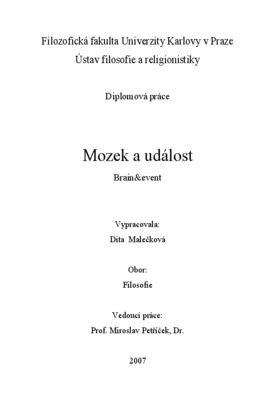Mozek a událost
Brain and event
diplomová práce (OBHÁJENO)

Zobrazit/
Trvalý odkaz
http://hdl.handle.net/20.500.11956/13421Identifikátory
SIS: 49989
Katalog UK: 990008833400106986
Kolekce
- Kvalifikační práce [24991]
Autor
Vedoucí práce
Oponent práce
Fulka, Josef
Fakulta / součást
Filozofická fakulta
Obor
Filozofie
Katedra / ústav / klinika
Ústav filosofie a religionistiky
Datum obhajoby
17. 9. 2007
Nakladatel
Univerzita Karlova, Filozofická fakultaJazyk
Čeština
Známka
Dobře
Záměrem této práce bylo nastínit vztah vidění a myšlení a prostoru, ve kterém se pohybují. V první části jsem upřesnila, že vidění není bezproblémovým automatickým dějem. Popsala jsem, co mají vidění a myšlení společné, v čem se tyto dvě oblasti lidského poznání liší a čím se inspirují, což mě přivedlo k otázce vztahu k pohybu a tělesnu. V druhé části jsem dospěla k tématu prostoru - prostoru vidění a prostoru myšlení ve formě "vnitřní krajiny" a také proměnám podoby prostoru ve vědě - viz studie topologického prostoru, či kyberprostoru. Ve třetí části jsem se věnovala tématu chaosu a jeho vztahu k vidění a myšlení a také vztahu chaosu a kreativity ve třech oblastech lidského poznání - filosofii, umění a vědě - který jsem se pokusila specifikovat na konkrétních příkladech filosofa (Deleuze), umělce (Boudník) a vědce (Mandelbrot). Ve čtvrté závěrečné části jsem se zabývala vztahem chaosu a "mozku", neboli aktuálního stavu lidského poznání a vztahu myšlení ke svému vnějšku; mozku k události. Práci jsem uzavřela vysvětlením pojetí noosféry. V celé práci jsem využívala především děl francouzských filosofů Henri Bergsona, Gillesa Deleuze, Michela Foucaulta, Maurice Merleau-Pontyho, Teilharda de Chardin a částečně také Jean-Francoise Lyotarda, či Paula Virilia. Z českých autorů to byly texty Michala Ajvaze, či...
In my work I aspired to clarify the relationships between the vision and thinking. In the first part I was above all trying to show that the vision is not unchallenged, automatic process. Than I specify the intersection between vision and thinking and I went to the problem of motion and corporality (sensuality). In the second part I arrived to the theme of the space - with regard to the vision and thinking, as a "inscape", and I also outlined the probleme of metamorphosis of space in forms of toplological space, virtual space, or cyberspace. In the third part of my work I developed the theme of chaos and the afinity of chaos and creativity in three zones of human creativity - philosophy, art and science - on the concrete examples of three creators: philosopher (Deleuze), artist (Boudník) and scientist (Mandelbrot). In the last part I concluded with the question of connection of chaos and "brain" as the actual degree of the human knowledge, and also with the contexture of the brain and the event. And I finished with the notion of noosphere. The whole writing is based mainly on work of the french philosophers Henri Bergson, Gilles Deleuze, Michel Foucault, Maurice Merleau-Ponty, Teilhard de Chardin and partly also Jean-Francoise Lyotard or Paul Virilio. From the czech authors it is Michal Ajvaz or Egon Bondy.
